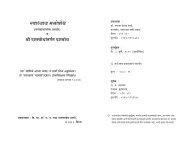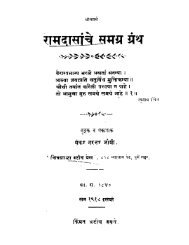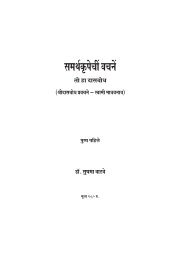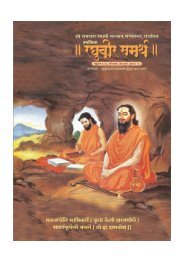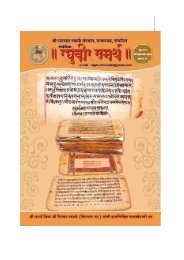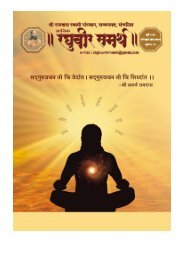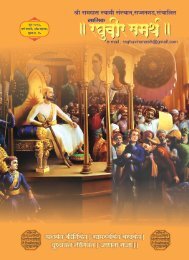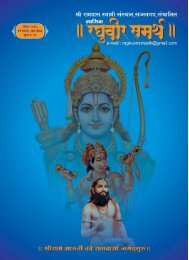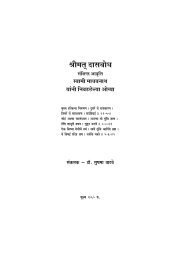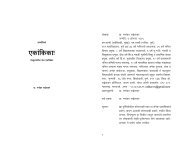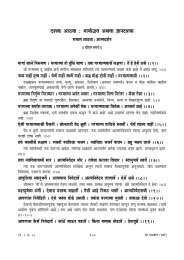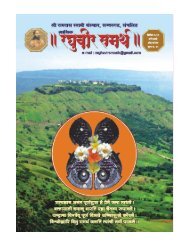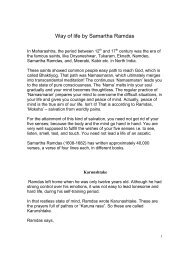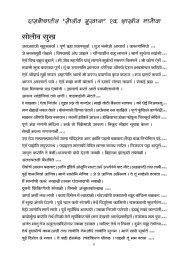THE DASBODHA BY: SADGURU SHREE SAMARTH RAMDAS ...
THE DASBODHA BY: SADGURU SHREE SAMARTH RAMDAS ...
THE DASBODHA BY: SADGURU SHREE SAMARTH RAMDAS ...
Create successful ePaper yourself
Turn your PDF publications into a flip-book with our unique Google optimized e-Paper software.
Shree Samarth finally says that the being undergoes all types of grief<br />
on account of the feeling that he is “The Body”, with the onset of the real knowledge that he is<br />
“The Atman” confers on him total bliss.<br />
END OF <strong>THE</strong> EIGHTH SAMAS<br />
<strong>THE</strong> NINTH SAMAS – SIDDHALAKSHAN (<strong>THE</strong> SIGNS OF <strong>THE</strong> SIDDHA)<br />
One who is in complete unification with his own self is the Siddha.<br />
The own self which also called the Atman, the Brahma or the Parbrahma is the aim of the<br />
deliberations in the Vedas and they have called it as the only thing which is not only permanent,<br />
creator of all else but also the creator of itself.<br />
The Siddha from within is completely united with the real self but<br />
from without his bodily karmas continue which are akin to the things happening in a dream. He<br />
never ever separates from the Atman and therefore although he seems to be amongst all he really<br />
speaking isn’t in them at all. He has no worries. For others he seems to be a Sadhak all the time but<br />
factually he isn’t. Yet as he knows everything about himself he continues his Sadhana with the<br />
fullest faith and without any doubt. He also is always in a state of complete bliss from within and<br />
without irrespective of the state of his body. The secret of attaining the state of the Siddha is the<br />
constant unification with the Atman forever from deep inside despite the fact that the body has to<br />
do its destined karmas. The Siddha has no desires and lusts. He is devoid of anger or hatred. The<br />
basic reason for this is the fact that he is enlightened about the self and sees it in everything and<br />
thence realizes that everything else is nothing but the reflections of his own self and that being the<br />
case there is nothing left for the desires or lusts and nothing to be frowned upon or hated.<br />
The Siddha doesn’t engage himself in any type of unnecessary<br />
debates, he is free from any of the diseased states of either the body or the psyche, he is beyond the<br />
boundaries of the visible because he has reached and unified with the Parbrahma by leaving behind<br />
the visible. He has nothing to do with the basic elements as he knows that they are the creations of<br />
the Maya. He doesn’t grieve about anything because he sees himself in all the forms. He isn’t<br />
affected by anything as he has dissolved his mind and thence doesn’t allow it to come into play<br />
anytime. He thus isn’t either apprehensive or afraid of anything. He doesn’t differentiate between<br />
anything for he himself sees them as his own expressions. For the same reason he is very soft in his<br />
behavior towards one and all.<br />
The Siddha isn’t bothered about the future. As he becomes the<br />
Parbrahma himself he acquires everything associated with it and therefore being without any<br />
attributes he never feels anything for his body as it ceases to exist for him. He reaches that<br />
transcendental where the normal human mind can’t even imagine reaching. Like the Parbrahma he<br />
also is the purest thing imaginable or really speaking beyond imagination. He forever lives in the<br />
formless form of the Parbrahma and not for a single moment loses his unification with it.<br />
Shree Samarth therefore advises us to have the companionship of the<br />
Siddha by which we also can imbibe his qualities. He also tells us to practice and study how to<br />
remain in the state of the Atman. He asks us to keep our wisdom at the place of the Atman<br />
unwaveringly. This will at least help us in shedding our vices. Shree Samarth says that different<br />
people living in different conditions get different types of experiences which will be described in<br />
the next samas.



